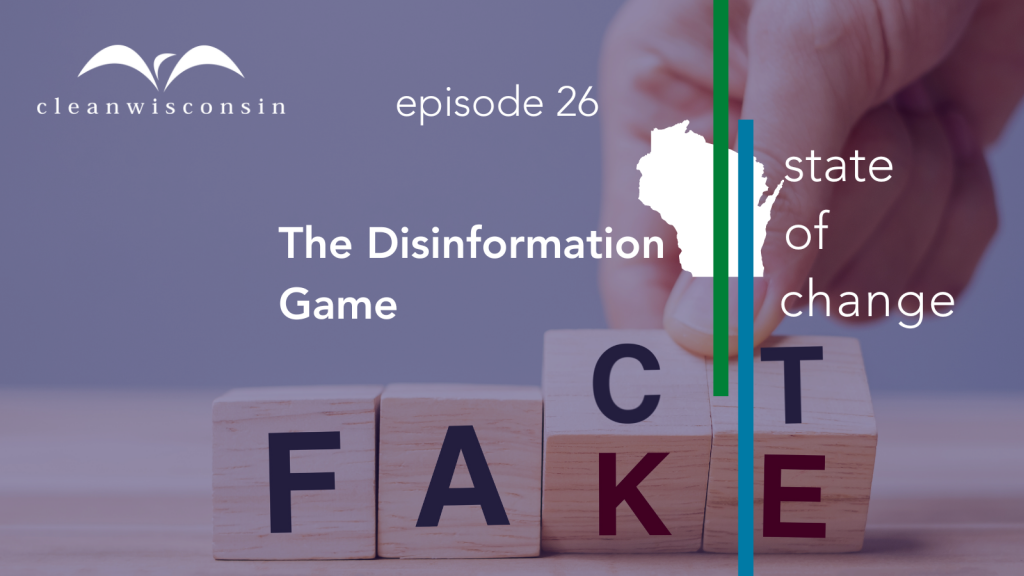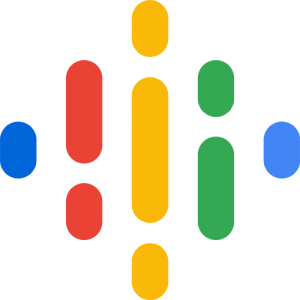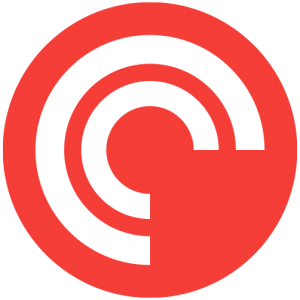Don’t believe everything you read on Facebook. Everybody knows that, but somehow misinformation still spreads like wildfire on social media, especially when it comes to climate change and clean energy like wind and solar. A sea of misinformation is getting in the way of badly-needed clean energy projects.
Where are the false claims coming from, and why do people believe them? In this episode, what you can do to battle back – and recognize when disinformation is working on you.
Host: Amy Barrilleaux
Guest:
Dr. Sedona Chinn, assistant professor of Life Sciences Communication at the University of Wisconsin-Madison
Background Reading:
Politicization and Polarization in Climate Change News Content, 1985-2017
Wind and solar emerge as cheapest options for powering Wisconsin
Wisconsin’s Roadmap to Net Zero by 2050
Where to Listen:
Full Transcript:
Amy Barrilleaux: Scientific, peer-reviewed studies. Turns out they just don’t hold a candle to what your neighbor says. Or your friends on Facebook. And that can be really bad news when it comes to fighting climate change. A sea of misinformation is getting in the way of badly-needed clean energy projects.
Joining me is Dr. Sedona Chinn assistant professor in the Department of Life Sciences Communication at the University of Wisconsin-Madison. You have done a lot of research around how social media affects perceptions of credibility and expertise, especially when it comes to climate change. You even teach a class on misinformation. When you start talking with your students about that topic, what are some of the misconceptions that they have walking in the door of the classroom?
Sedona Chinn: Two things. First, they often come in with this idea that people who believe misinformation are stupid or wrong or crazy or morally bad in some way. And that’s not the case. We’re all vulnerable to believing misinformation. And the second issue is that a lot of people believe that misinformation is fundamentally a problem of information. And yeah, that’s part of it. But not entirely. Just giving people correct information is not likely going to really address the roots of somebody who strongly believes in some misinformation. Just giving them correct information is likely not going to be enough because you’re not addressing sort of why they came to believe that misinformation in the first place. So those are the two big misconceptions that I get in my class that we work a lot to overcome.
Amy Barrilleaux: In Wisconsin, we’re noticing a lot of misinformation around clean energy — health impacts of wind turbines is a big one. And no matter how many credible scientific studies get put out there, these myths continue and are even growing. So if this isn’t about, you know, people just haven’t seen that credible factual information, if they’re just not well informed on climate change or renewable energy, what is it about then? Why do all these false and misleading claims take hold?
Sedona Chinn: A lot of times the roots of why people believe misinformation have more to do with how that information has come to be aligned with their prior beliefs and values, worldviews and identities. On their emotional reactions. Fear and anger in particular are drivers of belief in misinformation, as well as sort of the social context. What is their community value and what are their community norms? Can lead people to believing or going along with misinformation.
Amy Barrilleaux: I think probably misinformation and disinformation, which is the intentional spread of false information, has existed forever–since we started talking to each other. But how has social media amplified that or made that an even more serious thing to worry about in our society?
Sedona Chinn: Yeah. So as you were saying, sort of as long as there have been groups of people, there has been inaccurate information circulating, whether that’s rumors or something else. Part of the reason why social media is a driver of misinformation is that it gives a lot of people a voice to network with people who might share similar views, who might not necessarily be their neighbors, who might not be directly in their communities, but it allows sort of access resources and information sharing across space. And that’s an amazing thing for a lot of different causes, but it can also lead to people to come together over their shared belief in misinformation and to organize over their shared misperceptions.
Amy Barrilleaux: When you go on some of these sites, these Facebook groups, and look at what’s out there in terms of information sharing about wind projects, it’s overwhelming because it’s not like it’s just one thing or two things. There’s a lot of, you know, I felt like it was kind of a soup of misinformation, that was it was hard to navigate some half truths or cherry picked information or a few facts here. How hard is it to for somebody to go in and disprove claims about any kind of controversial subject that’s out there?
Sedona Chinn: It’s incredibly difficult. And we see this sort of “misinformation soup,” as you said, across different domains as well, like food and nutrition, and a lot of these, sort of like, here’s some accurate information alongside some inaccurate information. And that can be really difficult for people who aren’t experts in wind turbine engineering to try and understand. It’s certainly difficult even for people who do have some knowledge to understand it. And a lot of times people overestimate how good they are at seeing and spotting fake information, which is important to recognize. But also this sort of twisting of information or cherry picked information reflects how we process information. That is, when you have a strong belief, you’re likely to engage in motivated reasoning, which is our tendency to interpret new information in a way that confirms what we already know and believe. And so that might mean, you know, if you’re a sports fan and you see a play, the fan from one side is going to interpret that play as, “Oh, that was a foul.” And the other side is going say, “Oh no, that ref was completely wrong and they’re biased against me.” And if the same thing happens with the team switching places, the fans are going to switch sides so that you interpret that information in a way that supports your team. And in the same way we see this in, you know, science information. If you have a strong prior belief, you’re likely to interpret scientific evidence and information that people might be sharing to correct your misperceptions in a way that supports what you already know and believe. And that’s one way that human brains work, especially when that position on, say, renewable energy is or a sports team is strongly associated with your personal identities, whether a partisan identity, a fandom, whatever that might be.
Amy Barrilleaux: One thing that we’re noticing in some communication around these big solar farms or wind farms in Wisconsin is kind of playing on the rural urban divide. So people saying, you know, “You’re going to have to deal with the wind turbines and the energy is going to go to the cities and it’s going to impact our rural landscape.” Are you surprised that there is this kind of tendency to hit on the things that are already dividing us?
Sedona Chinn: We know that people who are strategically spreading disinformation often are strategically playing to existing social divides and divisions and existing conflicts because people are more likely to engage in that biased information processing. They’re more likely to uncritically accept information if it’s already playing to this distrust that people have.
Amy Barrilleaux: I think it’s easy sometimes to dismiss people who spread false information as naive or trolls or acting with bad intentions. But if I’m being honest with myself, if I were scrolling through my own Facebook feed and I saw a post, you know, maybe Ten Terrible Facts about Coal Plants, I already don’t like coal plants. I know they’re bad. So I can’t say for certain that I would fact check every single piece of information in that post before sharing it. I’m going to assume it’s right because it fits in with what I already think. So is that kind of a weakness for everybody, that there could be some disinformation out there playing on what you think and believe?
Sedona Chinn: Yeah, and that’s a great example of the way we tend to be less critical of information that agrees with us and agrees with what we already think we know. We tend to think that information is is more valuable or more worthy of consideration than information that disagrees with us. And if we get to a point where we can’t spin this information in a way that agrees with us, we can’t say it’s unimportant, then that’s when you are more likely to see rejection of that information or trying to discredit the source of that information. If you can’t reinterpreted in some biased way, you’re more likely to see it counter-argued or rejected.
Amy Barrilleaux: What can people who are listening to this do? I mean, if they see something about climate change or clean energy or any other thing that they they know is incorrect, it feels like it’s a mountain of disinformation, what can we possibly do to kind of battle back against that?
Sedona Chinn: There’s actually a lot you can do. And it’s important to remember that, especially on like Facebook, you have two audiences who are seeing this misinformation. You have the people posting it, people in in groups that are promoting misinformation, perhaps, that are already strong believers. They’re one audience, and the other audience is the people who see these posts but really don’t know or really don’t care. These are people who are not really engaged or interested in renewable energy projects. And the corrective strategies for those two audiences are different, and that’s really important to bear in mind. Now, one thing you can do if you see, for instance, a Facebook post that has some misinformation in your community and we have research on this, this is a research backed strategy, is you should feel empowered to leave a quick comment on it, to say very politely, “Hey, I’m not 100% sure that’s right.” One sentence of correct information, very brief, and a link to a reputable source. Now, this is probably not going to change the mind of the person who posted it. After all, they just publicly declared that they believe this misinformation. But research shows it actually does go a long way in preventing the spread of misinformation among their friends and their family and community who are going to run into this post while scrolling through their own Facebook feeds. So that’s something that you can feel empowered to do, knowing that that does make a difference. But it’s important when engaging on social media to remember not to be so confrontational. There’s a sort of a tendency to want to jump in and fight and defend and tell them they’re wrong. But I’ve never admitted I’m wrong when I’m being yelled at. It’s not something that’s comfortable. It’s going to make them more defensive and reactive. So it’s important to stay polite, unemotional. Just a quick, “Hey, I’m not 100% sure that’s right. Here’s some quick information. Here’s a reputable source.” Bonus points, if that’s a reputable source in your community, and then move on with your day.
Amy Barrilleaux: So don’t check back to see who replied or anything like that. If you can help it.
Sedona Chinn: You can if you want. But some people find that very stressful!
Amy Barrilleaux: So I guess you can kind of see it as instead of letting one point of view totally take over the conversation, it’s about sowing the seeds of doubt for the people who are just kind of casually, they’re looking at something, not commenting.
Sedona Chinn: Yeah, because there can sometimes be sort of a false perception that, “Oh, everyone in my community opposes the solar project.” When really it’s a small group of people who are really vocal, and people who might support the solar project or just don’t feel empowered to speak out about it or might do so privately. So there can be this sort of false perception that a group, an opinion that’s strongly held by a small group of people, is the dominant opinion in your community. And that’s important because we tend to conform to the norms of our community. We want to be liked and accepted by our community. It’s important, especially in sort of a community that’s more tight knit and small and where those relationships really matter.
Amy Barrilleaux: We hear a lot about trusted sources of information. You know, I think climate scientists would like to think that they are trusted sources. Scientists who are studying say health impacts of wind would like to think that they are trusted sources. But when it comes down to it, that’s not really what we’re talking about.
Sedona Chinn: No, we’re talking a lot about people who are the sort of trusted members of the community who are, you know, have been leaders in the community and that are well-respected by that community. It’s important sometimes, you know, sometimes the trusted source will be an academic expert. But it’s also important to bear in mind that when there’s existing distrust, as there might be in some rural communities between academic, industry and government institutions and these rural communities, that it’s important to sort of bring on board leaders from that rural community so that they can be trusted leaders who can spread your message and can spread accurate information.
Amy Barrilleaux: So as you teach students to go out into the world and start recognizing misinformation and disinformation and maybe start taking steps to battle against it, do you have hope that we will get a handle on this problem, when it comes to social media, at least?
Sedona Chinn: Limited hope, if I’m being completely honest. Social media is a place where everyone can share what they think. And there’s a part where it’s sort of at what point do you intervene? We talked a bit about the misinformation is not always clear cut. It’s not just somebody made something up. It’s this comes from a scientific study, it was just taken out of context. How do you correct that information versus a completely fabricated news article? And the nuance in there in terms of the the amount of resources it would take to actually fact check the information online are astronomical. So I don’t expect that we’re going to see, you know, mass removal of misinformation any time soon. I don’t think anyone has the resources or capability to do that. And it is problematic in some ways because to what extent are there different opinions or interpretations of a study? To what extent is that misinformation or to what extent is that different policy views? And it’s important that we have that conversation that engages with different values and engages with different policy perspectives. Because I think one of the things at the root of the misinformation that you’ve been sharing with me is sort of feeling excluded from that policymaking process, feeling neglected by these groups coming in to install large solar projects, feeling like they’re not being listened to. And so part of addressing the misinformation, honestly, is listening seriously to the concerns that these people may have, and that might be part of why they fell prey to the misinformation. And so part of correcting it is listening seriously to their concerns and and responding to them.
Amy Barrilleaux: And maybe there’s a lesson for all of us when we’re on our social media to recognize when we might be vulnerable, when posts might be playing into what we already believe.
Sedona Chinn: Yeah, in particular to note, when you’re having an emotional reaction to something, that’s a big one on social media. Whether it pulls at your heartstrings or whether it makes you really angry and incensed. A lot of times these kind of emotional tactics are the way that misinformation spreads. And they’re the things that make us share information on social media. So it’s important to sort of make a mental note of like, “Huh, I reacted to that. I wonder why that is?” And just just be aware of it as you’re going through your day.
Amy Barrilleaux: That makes sense. Or you can be like me and I’m just like 100% cat videos now on my social media! Dr. Sedona Chinn from UW Madison Department of Life Sciences Communication, thank you so much for talking with me. To find out more information about the need for clean energy in Wisconsin, log on to clean Wisconsin dot org. I’m Amy Barrrilleaux and you’ve been listening to state of change from Wisconsin.






